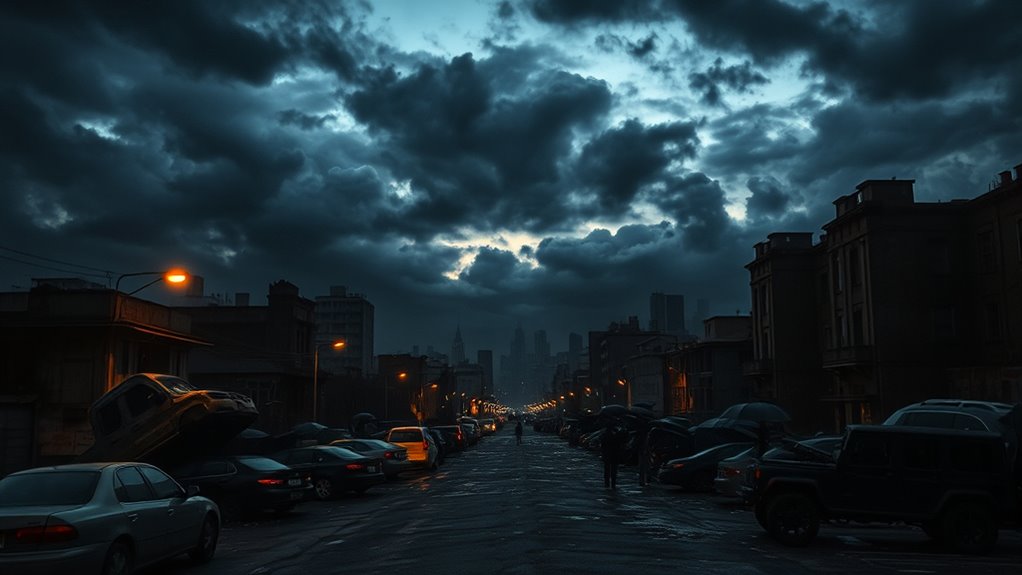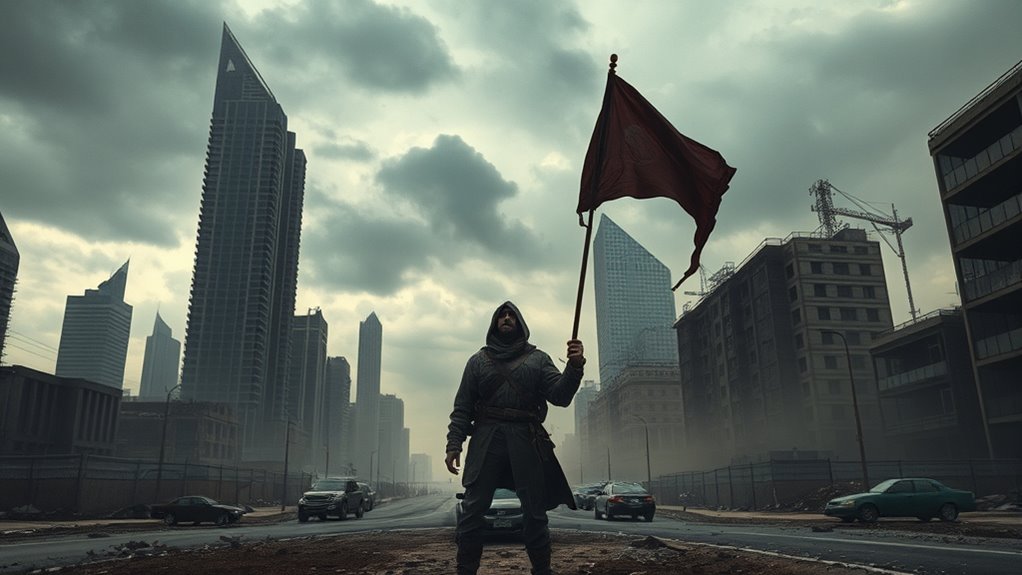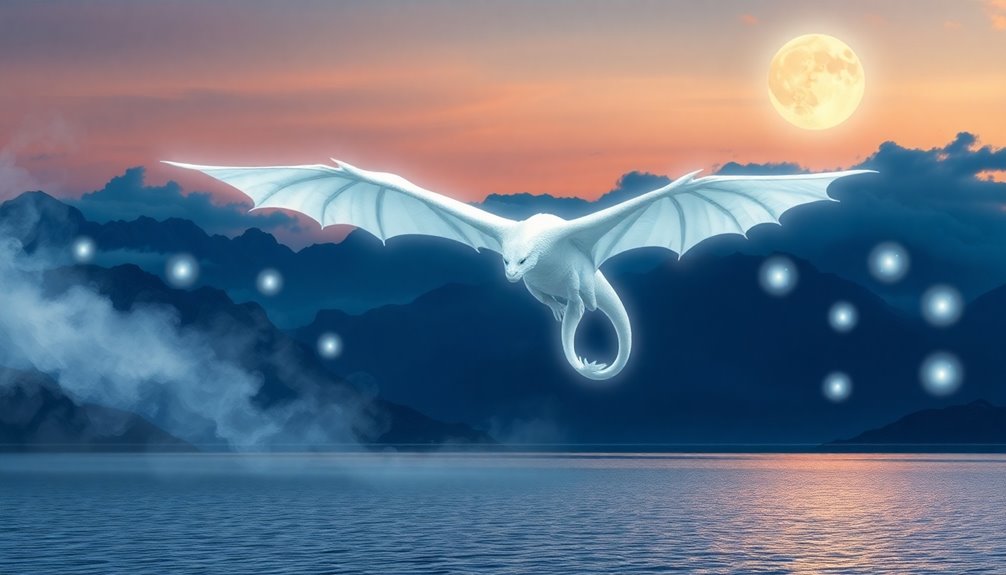Apocalypse dreams often reflect collective fears shaped by cultural symbols, media influences, and shared stories of destruction or renewal. You might notice these dreams echo societal anxieties about climate change, war, or societal collapse, fueled by movies, news, and myths. These images serve as a universal language of fear and hope, connecting individual dreams to broader cultural narratives. If you pay attention, you’ll discover deeper insights into how society’s collective anxiety influences your subconscious.
Key Takeaways
- Apocalypse dreams often symbolize collective societal fears about destruction, renewal, and divine judgment rooted in cultural symbols.
- Media influences amplify collective anxiety by reinforcing apocalyptic themes through movies, news, and pop culture.
- Shared symbols in dreams serve as a universal language reflecting societal fears and cultural messages of disaster or hope.
- Mythological narratives and media distortions shape the content of dreams, mirroring cultural anxieties and collective subconscious.
- These dreams embody cultural hopes and fears, revealing underlying societal currents and influencing collective mental landscapes.

Dreams of apocalyptic scenes often reflect more than just personal fears; they mirror cultural anxieties and collective uncertainties. When you experience visions of the world ending, you’re not just tapping into individual worries but also engaging with shared symbols and narratives that have permeated society through mythological symbols and media representations. These symbols—such as floodwaters, fire, or falling stars—resonate across cultures, serving as archetypes that symbolize destruction, renewal, or divine judgment. They tap into deep-seated collective memories and fears, shaping what your subconscious conjures during dreams. Media representations play a significant role in amplifying these fears, often depicting humanity’s worst-case scenarios through movies, news stories, and popular culture. Films like “Mad Max” or “The Road” portray bleak futures that seep into your subconscious, coloring your dreams with images of chaos and collapse. These portrayals, reinforced by headlines about climate change, pandemics, or nuclear threats, reinforce a shared narrative of impending disaster, making such themes a common thread in collective dreaming. Additionally, the cultural significance of these symbols helps explain why they recur so frequently in collective dreams and stories across different societies.
Your dreams are influenced by these cultural symbols and media narratives, which act as a collective language of fear. They shape how you interpret signs of danger—whether it’s a natural disaster, societal collapse, or technological catastrophe. When you dream of a collapsing city or a world engulfed in flames, it’s likely a reflection of societal fears magnified through mythological and media lenses. These symbols aren’t random; they embody universal fears that have persisted through history, often linked to stories of divine punishment or renewal. Media, in particular, magnifies these symbols, sometimes distorting or exaggerating them, which in turn influences the collective subconscious. Your dreams, in this context, become a way for your mind to process and make sense of these pervasive cultural messages. They serve as a mirror, revealing what society collectively fears and hopes for, often in exaggerated or symbolic forms.
Ultimately, these apocalyptic dreams are more than personal nightmares—they’re a reflection of the cultural landscape you live in. As mythological symbols and media representations continue to shape societal fears, your subconscious integrates these elements into your dreams, creating a shared visual language of collective anxiety. Recognizing this connection can help you understand that your fears are part of a larger cultural dialogue, one that echoes through stories, images, and symbols passed down through generations. In this way, your dreams serve as a window into the collective psyche, revealing the underlying currents of cultural hope and dread that influence everyone.
Frequently Asked Questions
How Do Different Cultures Interpret Apocalyptic Dreams?
When you explore how different cultures interpret apocalyptic dreams, you see that cultural symbolism plays a big role. Some view these dreams as warnings or messages from spiritual domains, while others see them as reflections of personal or societal anxieties. Dream interpretation varies widely, influenced by cultural beliefs and myths. You might find that in some cultures, these dreams symbolize renewal, whereas in others, they signal impending disaster.
What Role Does Media Play in Shaping Collective Anxiety?
Imagine media as a magnifying glass, intensifying tiny sparks of fear into blazing fires. It influences your collective anxiety by shaping perceptions and spreading stories that amplify fears of catastrophe. Through headlines, images, and narratives, media influence fuels worry, making you feel like you’re walking a tightrope over an abyss. This fear amplification keeps society on edge, feeding the cycle of collective anxiety that seems unstoppable.
Are There Historical Parallels to Modern Apocalypse Fears?
When you look at historical parallels, you’ll see that end time visions and ancestral prophecies have long fueled humanity’s fears of apocalypse. Throughout history, societies have interpreted natural disasters, plagues, or social upheavals as signs of impending doom. These fears mirror today’s anxieties, showing that collective fears of the end times are deeply rooted in cultural and spiritual traditions, constantly resurfacing during times of crisis or uncertainty.
How Do Personal Experiences Influence Dream Symbolism?
Your personal experiences shape dream symbolism by tapping into subconscious influences, making symbols unique to you. When you encounter stress or joy, your mind interprets these feelings through personal symbolism, reflecting your inner world. These symbols act as subconscious messages, helping you process emotions and memories. By paying attention to your dreams, you gain insight into hidden thoughts, showing how your experiences directly influence the symbolism that emerges during sleep.
Can Collective Anxiety Affect Societal Behavior Long-Term?
Imagine a small fire spreading through dry grass—that’s how collective anxiety can shape society long-term. When mass hysteria takes hold, it tests societal resilience, potentially causing shifts in behavior, policies, or norms. Over time, this anxiety can either strengthen community bonds or lead to division. Your awareness of these dynamics helps you understand how shared fears influence societal evolution, shaping collective actions well beyond initial fears.
Conclusion
Your dreams of apocalypse are like whispers from the collective soul, echoing fears we all share beneath the surface. They’re a mirror held up to society’s anxieties, reflecting our hopes and dread tangled together. Embracing these visions, you can begin to decode what’s truly weighing on us—transforming fear into understanding. In this shared nightmare, you find the thread that links us all, reminding you that even in chaos, there’s a flicker of hope waiting to be seen.











